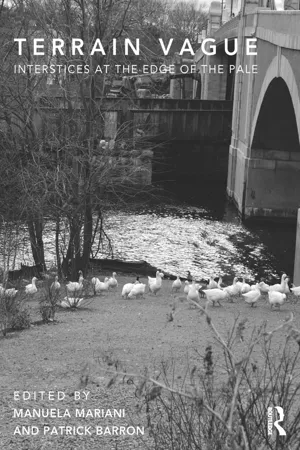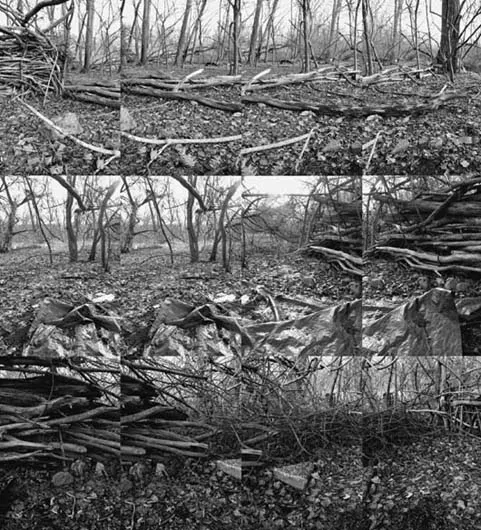![]()
Introduction
At the Edge of the Pale*
Patrick Barron
What if there is no “space,” only a permanent, slow-motion mystic takeover, an implausibly careening awning?
(Lisa Robertson, 2003, p. 17)
That zero panorama seemed to contain ruins in reverse, that is—all the new construction that would be built. This is the opposite of the “unromantic ruin” because buildings don't fall into ruin after they are built but rather rise into ruin before they are built.
(Robert Smithson, 1996a/1967, p. 72)
Seemingly abandoned or overgrown sites—where the landscape has gone to seed and been left to its own devices, is in suspended redevelopment, or is being furtively inhabited or otherwise used, under the radar of local authorities—can be found nearly everywhere within the margins and interstices of cities. Existing at the blurry edges of the built world, such areas cast doubt on spatial and behavioral codes. Whether vacant lots, derelict industrial sites, or unkempt border areas, these terrains vagues act variously as refuges, mirrors, and memento mori. Residual and ambiguous, they allow us to examine ourselves and our everyday surroundings from outside the frenetic circuits of work, commerce, and transit. As counter-spaces, terrains vagues are also containers of a fragmented shared history, illuminating the imperfect process of memory that constantly attempts to recall and reconstruct the past.
Terrains vagues are everyday areas that expose the stratified or palimpsest nature of all places, especially those with the appearance of codified stability where there exists, as Michel de Certeau (1984) puts it, a sense of “immobility” and “an illusory inertia” (p. 201). Terrains vagues are what the architect-and-artist collective Stalker (1996) calls, in its manifesto, “spaces of confrontation and contamination between the organic and the inorganic, between nature and artifice” that “constitute the built city's negative, the interstitial and the marginal, spaces abandoned or in the process of tranformation.” Terrains vagues can be thought of as subversive forms of Henri Lefebvre's (1991/1974) “spaces of representation” (complex, intimate, layered spaces), from whose perspective and amid whose remains we may examine the shortcomings of “representations of space” (designed or planned spaces) while seeking temporary retreat from dominant “spatial practices” (habitual behaviors that tend to reinforce spatial norms). All three forms of Lefebvre's loose triad are implicit in terrains vagues, which, although abandoned, are likely to be claimed and transformed into categorizable, built space in the future. Often terminally temporal, terrains vagues can be seen as shifting assemblages of contradictory nuances, especially in terms of particular sites' layered, frequently violent histories of displacement—part of the destructive and, at times, colonial nature of architectural projects (Solà-Morales, 1994). Many terrains vagues contain problematic series of eviction and erasure that, although difficult to trace, are critical to understanding how terrain vague is both a condition and a process.
1.1
Fire Pit, Wooded Debris Slope, State Laboratory (Boston, 2012)
Forms of “loose space” (Franck & Stevens, 2007), terrains vagues provide potential outlets for unexpected or spontaneous encounters, informal events, and alternative activities outside our increasingly commodified, controlled, and privatized “open” urban spaces. Many terrains vagues, especially those easily accessible, large enough, and containing interesting physical features, from empty buildings and ruins to varied vegetation and other natural features, are inviting to a range of people to make creative, unintended, and unplanned use of them—becoming “animated ‘indeterminant spaces’” or “free-zones” (Groth & Corijn, 2005). Because they are thus temporarily appropriated, often without permission, as forms of public space, and because they are widely viewed as empty and useless, terrains vagues are particularly well suited for critical appraisal of all that is external to them. In this regard, terrains vagues can also be understood within the purview of Michel Foucault's (1967) “heterotopias,” especially as conceived of as “counter-sites” in which “all the other real sites that can be found within the culture are simultaneously represented, contested, and inverted.” Of special note are the heterotopias he identifies as linked “to time in its most flowing, transitory, precarious aspect, to time in the mode of the festival,” giving the example of “fairgrounds, these marvelous empty sites on the outskirts of cities”—although, as Gil Doron (2008) skeptically notes, such sites “have never been empty” (p. 204).
Many terms have been used to describe abandoned, leftover areas: “derelict land” (Barr, 1969; Kivell & Hatfield, 1998; Oxenham, 1966); “zero panorama,” “empty or abstract settings,” and “dead spots” (Smithson, 1996a/1967; 1996b/1968; 1970, as cited in Reynolds, 2003); “vacant land” (Bowman & Pagano, 2004; Northam, 1971); “wasteland” (Gemmell, 1977; Nabarro & Richards, 1980); “il vuoto” (“the void”) (Borret, 1999; Secchi, 1989/1984); “urban wilds” and “urban sinks” (Lynch, 1990); “new, nameless places” (Boeri, Lanzani, & Marini, 1993); “dross” (Lerup, 1994) and “drosscape” (Berger, 2006); “no-man's land” (Leong, 1998); “dead zones” and “transgressive zones” (Doron, 2000); “superfluous landscapes” (Nielson, 2002); “spaces of uncertainty” (Cupers & Miessen, 2002); and “le Tiers-Paysage” and “les délaissés” (“the Third Landscape” and, roughly, “leftover lands”) (Clément, 2003). Other common terms, among others, include “brownfields,” “in-between spaces,” “white areas,” “blank areas,” and “SLOAPs” (Spaces Left Over After Planning) Doron, 2007).
All of these terms have varyingly specific and useful, if often negative, connotations. “Wasteland,” “derelict land,” “drosscape,” and “brownfield” frequently refer to areas abandoned by industry and contaminated with toxic by-products; “vacant land” implies land currently “empty” and “unused” that would be improved if developed; “void” conjures up parking lots and highway buffer areas; “white area,” “blank area,” “SLOAP,” and “dead zone” indicate temporary oversight by planning commissions and developers; “superfluous landscape” may mean an extra or surplus area, but also an inessential one;
1.2
Wetland, Graffitied Wall, Train Tracks (Boston, 2012)
“nameless place” and “space of uncertainty” suggest ambiguity and transience; and “transgressive zone” implies a place for alternative or subversive activities. “The Third Landscape” is a broad category of areas of nonhuman landscape evolution; the more specific “les délaissés” are leftover places colonized by wild plants and animals. “Zero panorama” playfully recognizes the living evidence of present entropy and the promise of future entropies, inherent in all terrains vagues and beyond.
In choosing “terrain vague” as the key, overarching theoretical term for this collection of essays, we are drawing upon the work of Ignasi de Solà-Morales (1995), who adopted it to refer to marginal islands and oversights in the landscape, “mentally exterior in the physical interior of the city, its negative image, as much a critique as a possible alternative” (p. 120). The expression's seemingly paradoxical combinations of vacancy with freedom, of absence with possibility, and of limitlessness with mobility, are vital, he argues, to understanding the evocative potential of the full range of our interstitial urban areas—leftover, ever appearing—disappearing, and never clearly urban or rural.
As Solà-Morales (1995; 1996) and Luc Lévesque (1999) contend, the expression contains subtleties and opportunities for interpretation not possible in roughly equivalent translations in English (as well as other languages), such as wasteland, vacant land, and derelict land, which all contain restricting or negative qualifiers. “Terrain” (from the Latin terranum, or land) in French may mean a delimited portion of land, such as a lot, field, or site—either urban or
1.3
Squatter Campsite (Boston, 2013)
rural—as well as refer to ground, soil, or earth. In English, the term generally refers to a tract or extent of rural land, especially with regard to natural features; it may also, less commonly, mean position or standing ground. The closely related word, terrene, contains the additional twist of earthly or secular, as opposed to heavenly or spiritual.
Vague (from the Latin vacuus, or empty, and the German Woge, or wave) in French contains three main connotations: wave or billow; empty or vacant; and uncertain or indeterminate, its primary connotation in English. Rare or obsolete forms in English include prank; trend or fad; and to wander or stray. This last meaning is especially fitting, given that there are rarely clear paths through terrain vague, the exploration of which is best done with no clear destination or direction in mind—evident, for example, in Stalker's situationist-inspired traversings of the Roman periphery (Stalker, 2000); Lisa Robertson's (2003) meandering “Seven Walks from the Office of Soft Architecture” through half-dissolved cities; and Gabriele Basilico's “Eclectic Atlases”—rambling photographic explorations along various stretches of Italian sprawl (Basilico & Boeri, 1998). Terrain vague, indeed, contains within it a multitude of possible connotations, and is thus well suited to serve as a collective term for various subtypes of leftover land within the edges of the pale—boundaries that, as they proliferate, are also increasingly difficult if not impossible to delineate.
Cognizant of the dilemma that attempting to more clearly name or identify terrains vagues, much less categorize them, may indeed be a pointless exercise, given their mutable and ephemeral nature, we nonetheless here offer a rough outline of typical situations and sites in which they can be found. Often they are surrounded or run through by—and are, in part, a result of—what Marc Augé (1995) calls “non-places,” areas of transit or commerce in which users experience a heightened sense of anonymity and a compulsion to adhere to strictly codified behavior, such as freeways, shopping malls, railways, supermarkets, and airports. Terrains vagues that are less extensive in concentrated area may narrowly border non-places when they take the form of buffer zones,
1.4
Train Tracks, Charles River Footpath, Soldiers Field Road, Massachusetts Turnpike (Bosto...



